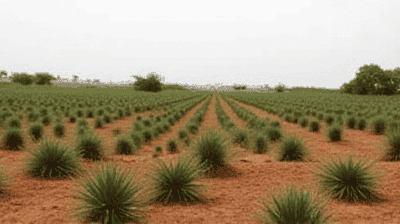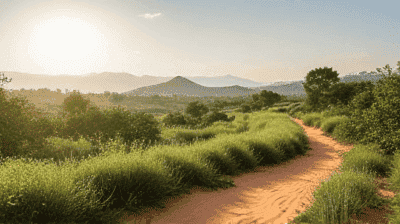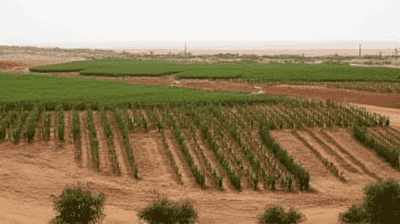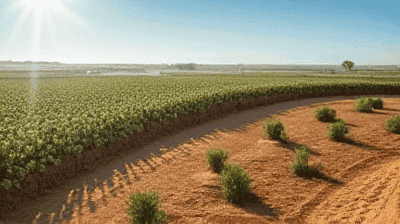
The Great Green Wall initiative represents one of the most ambitious environmental restoration projects in history, aiming to combat desertification and enhance food security across the Sahel region of Africa. Stretching from Senegal in the west to Djibouti in the east, the Great Green Wall is envisioned as a mosaic of trees, shrubs, and vegetation that serves as a barrier against the encroaching Sahara Desert. This bold project not only seeks to restore degraded land but also to mitigate the effects of climate change, improve livelihoods, and foster sustainable development in a region that is highly vulnerable to environmental challenges.
The idea of creating a green barrier to combat desertification in the Sahel dates back to the early 20th century, but it gained significant traction as environmental degradation and land loss became increasingly evident. The Sahara Desert's rapid expansion has resulted in the loss of fertile land, the depletion of water sources, and increased food insecurity in many communities.
The Great Green Wall was officially launched in 2007 during the African Union summit in Burkina Faso, where leaders recognized the urgent need to address the challenges posed by desertification and climate change. The initiative aims to restore 100 million hectares of degraded land by 2030, providing a sustainable solution to the environmental threats faced by the Sahel.
The Great Green Wall seeks to achieve several key objectives:
Land Restoration: The primary goal is to restore degraded ecosystems by reintroducing native vegetation and enhancing soil quality.
Biodiversity Conservation: By restoring ecosystems, the Great Green Wall aims to preserve and promote biodiversity, which is crucial for ecological stability.
Food Security: Improved land health is expected to enhance agricultural productivity, contributing to food security and better nutrition for local populations.
Climate Resilience: The initiative seeks to combat climate change effects and increase the resilience of communities to environmental shocks.
Economic Development: By creating green jobs and promoting sustainable land use practices, the Great Green Wall aims to enhance the livelihoods of local communities.

Since its inception, the Great Green Wall has seen a range of successes across various countries in the Sahel. Countries like Senegal, Burkina Faso, Nigeria, and Ethiopia have implemented significant restoration projects that demonstrate the potential of reforestation and land rehabilitation methods.
In Senegal, the Great Green Wall initiative has led to impressive results:
Reforestation Efforts: Over the past decade, Senegal has successfully expanded forest cover through the planting of native tree species, such as baobabs and acacias. Community-led initiatives have involved local populations in the planting and nurturing of trees.
Improved Soil Health: The introduction of agroforestry techniques has improved soil quality and fertility, allowing farmers to benefit from higher crop yields.
Biodiversity Enhancement: Efforts in Senegal have also contributed to the recovery of various plant and animal species, fostering greater biodiversity in restored areas.
Burkina Faso has made significant strides in implementing the Great Green Wall:
Community Involvement: The involvement of local communities in restoration projects has been key to the initiative's success. Farmers have adopted sustainable practices, such as contour farming and the use of organic fertilizers.
Water Management: Innovative water management techniques, such as half-moon planting pits and zaï pits, have been developed to optimize water retention and enhance crop productivity.
Economic Benefits: The initiative has created new economic opportunities through the promotion of non-timber forest products, generating income for local communities.
In Nigeria, the Great Green Wall has focused on restoring degraded lands in northern regions:
Afforestation Projects: Large-scale afforestation projects have been undertaken to combat land degradation, with collaborations between local communities and government agencies.
Education and Awareness: Educational campaigns have raised awareness about the importance of sustainable land management, leading to more responsible land-use practices.
The success of the Great Green Wall initiative has been bolstered by partnerships between various stakeholders, including governments, NGOs, international organizations, and local communities. Key collaborations include:
International Organizations: The United Nations Convention to Combat Desertification (UNCCD) and the Food and Agriculture Organization (FAO) have provided technical and financial support to countries involved in the initiative.
NGOs and Local Groups: Non-governmental organizations have played a crucial role in implementing restoration projects on the ground, often working closely with local communities to ensure their participation and empowerment.
Research Institutions: Collaborations with research institutions have helped develop and adapt innovative land restoration technologies, contributing to evidence-based practices.
The Great Green Wall initiative has had a significant positive impact on the communities involved:
Increased Food Security: By restoring degraded land and improving agricultural practices, the initiative has contributed to enhanced food security for many households, reducing dependency on external food sources.
Job Creation: The restoration efforts have created job opportunities in areas such as tree planting, nursery management, and sustainable agriculture, improving livelihoods for local populations.
Cultural Restoration: Reconnecting communities to their natural environment has revitalized traditional knowledge related to land management and biodiversity conservation.
Social Cohesion: The collaborative nature of the initiative has fostered social cohesion among communities, strengthening local governance and encouraging collective action.
Despite the notable successes, the Great Green Wall initiative faces several environmental challenges:
Climate Variability: Climate change poses a significant threat to the effectiveness of restoration efforts. Erratic rainfall patterns and extreme weather events can undermine the survival of newly planted trees and impact agricultural productivity.
Soil Degradation: Continued soil degradation in some areas limits the effectiveness of restoration efforts. Soil erosion, salinization, and nutrient depletion can hinder the growth of vegetation.
Invasive Species: The introduction of non-native species can threaten the success of restoration projects by outcompeting native plants and undermining biodiversity.
Socioeconomic factors also impact the success of the Great Green Wall:
Land Tenure Issues: Unclear land tenure rights can create conflicts over resources and limit community participation in restoration efforts.
Population Pressure: Rapid population growth in the Sahel region can lead to increased pressure on land and resources, making sustainable management more challenging.
Financial Constraints: Limited funding for restoration projects can impede progress and result in insufficient resources to support local communities in their management efforts.
Effective governance is vital for the success of the Great Green Wall:
Political Instability: Conflicts and instability in various Sahel countries can undermine commitment to the initiative and disrupt restoration efforts.
Coordination among Stakeholders: The involvement of multiple stakeholders can lead to challenges in coordination and decision-making, hindering efficient implementation.
Policy Support: Insufficient policy frameworks to support sustainable land management and address desertification can limit the effectiveness of the Great Green Wall initiative.

To assess the effectiveness of the Great Green Wall initiative, a variety of indicators can be used:
Land Area Restored: The total area of land successfully restored under the initiative is a key indicator of progress.
Biodiversity Metrics: Monitoring changes in plant and animal species diversity can provide insights into the ecological health of restored areas.
Soil Quality Assessments: Improvements in soil health, measured through indicators such as organic matter content and nutrient availability, reflect the success of restoration efforts.
Socioeconomic Benefits: Evaluating changes in agricultural productivity, food security, and income levels among local populations can gauge the impact of the initiative on community livelihoods.
Community Engagement: Measuring the level of community participation in restoration projects can indicate the initiative's success in fostering local ownership and empowerment.
To ensure the long-term success of the Great Green Wall, efforts must be scaled up in several areas:
Expansion of Restoration Projects: Increasing the scope of land restoration efforts can help meet the ambitious goals of the initiative, with a focus on linking biodiversity conservation with agricultural productivity.
Strengthening Community Engagement: Continued involvement of local communities is essential for sustaining restoration efforts, fostering a sense of ownership and responsibility toward the environment.
Enhancing Research and Innovation: Investing in research and innovative technologies for restoration techniques can contribute to more effective and resilient ecosystems.
Integrating the Great Green Wall initiative into broader policy frameworks can enhance its effectiveness:
Cross-Sectoral Approaches: Policies that link agriculture, environmental conservation, and climate adaptation can create synergies and optimize resource use.
Legal Frameworks for Land Tenure: Clear land tenure policies that promote equitable access to resources can empower local communities and reduce conflicts.
Climate Adaptation Strategies: Incorporating climate resilience measures into restoration projects can help communities better adapt to changing environmental conditions.
Collaboration among stakeholders will be imperative as the initiative progresses:
Regional Cooperation: Strengthening cooperation across Sahelian countries can enhance knowledge sharing, resource mobilization, and joint efforts in combating desertification.
Public-Private Partnerships: Engaging the private sector in the initiative can attract investment and expertise, supporting sustainable development in the region.
Global Network of Support: Building a global network of support for the Great Green Wall initiative can help mobilize resources and amplify its impact on climate change and environmental conservation.

The Great Green Wall initiative represents a vibrant and hopeful response to the pressing challenges of desertification, climate change, and food insecurity in the Sahel region of Africa. While significant progress has been made in restoring landscapes, enhancing biodiversity, and improving livelihoods, challenges remain that must be addressed to ensure the initiative's long-term success.
By strengthening community engagement, scaling up restoration efforts, and promoting collaboration across sectors, the Great Green Wall has the potential to not only halt desertification but to transform the Sahel into a more resilient and sustainable region for future generations. The world is watching the progress of this monumental undertaking, and its success could serve as a model for global efforts to combat climate change and promote environmental restoration.
Through collective action, innovation, and unwavering commitment, the Great Green Wall can flourish, creating a barrier against the desert while nurturing the land and communities within its embrace.